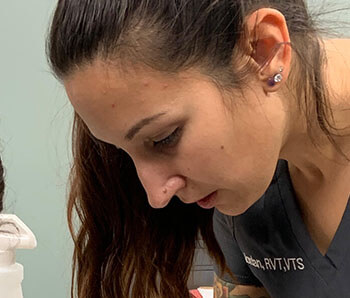Hyperadrenocorticism, or Cushing’s disease, is when the adrenal glands within your pet’s body are producing excess hormone levels. Anatomy lesson first. Next to each kidney, is one adrenal gland. “Ad” refers to “next to”, and “renal” refers to kidney; adrenal. The adrenal glands function by working together with the pituitary gland, which is located at the base of the brain, to regulate the body’s hormone levels. The pituitary gland produces a hormone called adrenocorticotropic hormone, or ACTH, while the adrenal glands produce a steroid hormone called cortisol. So, how do they work together? When the pituitary gland produces ACTH, the ACTH stimulates the adrenal glands to produce cortisol. Cortisol is produced to help your pet’s body respond to stress, manage blood sugar, control weight, and help fight infections. The presence of cortisol in the body exerts a negative feedback to the pituitary gland, suppressing ACTH production, to ensure a proper balance of your pet’s hormones.
Technically, there are three “different” types of Cushing’s disease: Pituitary Dependent Hyperadrenocorticism (PDH), Functioning Adrenal Tumor (FAT), and Iatrogenic Hyperadrenocorticism (secondary to glucocorticoid administration). However, for the sake of this blog, we will be discussing the most common type, pituitary dependent hyperadrenocorticism, which occurs in 80%-85% of dogs with Cushing’s disease. With PDH, the feedback loop is disrupted by a tumor sitting on the pituitary gland. This means the pituitary gland does not receive the signal from cortisol being produced to stop producing ACTH. In turn, this creates “swollen” adrenal glands that are also consistently producing excess cortisol in response to the ACTH production.
This disease tends to be seen more in certain species and breeds. Dogs tend to be more affected than cats, with the specific breeds predisposed being poodles (especially miniature), boxers, Boston terriers, dachshunds, and Yorkshire terries to name a few. These excess hormone levels can cause you to see some signs at home; excess drinking, excess urinating, increased appetite, lethargy, abdominal enlargement (“pot-bellied”), panting, hair loss, and thin skin to name just a few.
Your veterinarian will likely recommend running lab work including a chemistry panel, complete blood count (CBC), and urinalysis to rule out other disease processes. The gold standard test to confirm Cushing’s disease is an ACTH stimulation test. In this test, a “pre” or a baseline sample of blood is drawn. Then, a synthetic form of ACTH is administered to your dog, and after one hour, a “post” sample is drawn to measure your dog’s cortisol response. In a dog with Cushing’s disease, their cortisol levels will be elevated, due to the feedback loop being interrupted. An abdominal ultrasound may also be recommended rule out other diseases, as well as measure the adrenal glands or determine if there is an adrenal tumor causing your pet’s symptoms.
Once a diagnosis of PDH has been made, your veterinarian may recommend a medication to help control your pet’s disease. A medication called trilostane, may be recommended, which inhibits the synthesis of adrenal cortex hormones. Once medications have been started, ACTH stimulation testing will be repeated to ensure dosing adjustments can be made according to response. It is also important to monitor your pet’s response to medication at home. This includes keeping an eye on your pet’s thirst, hunger, urination, and any other symptoms you may have been seeing at home. The goal of treating your pet’s Cushing’s disease is to minimize symptoms seen at home and improve your pet’s quality of life. Keep your veterinarian informed with any changes you are noting at home, and follow medication recommendations made by your veterinarian.

Author:
Jordan RVT, VTS, (SAIM)
Ph: (912) 721-6410
Contact Us
